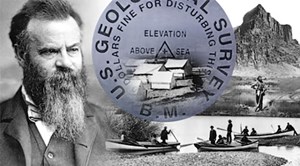What's new in exploration
Every explorationist asks where are we looking, sometimes why, with what, and, always, when? What happened and where—with “the other” people’s money—and what technology was used? What the heck is Tau P anyway? We get 3D. Wikipedia is a great place to start looking, even if it’s not always correct. It is at least a place to spell-check and find definitions. But you want more. Both technology and well histories, but one can’t visit everyone’s well, or can you?
SPE PetroWiki is perhaps the most technical, and most tutorial, public site out there, and it is more or less free to the viewer. It is a treasured resource that SPE has spent tens of thousands of hours putting together, thanks to volunteers who are hands-on with the topics they explain.
SEG also has a wiki. Earlier offerings were a library of boring, equation-based SEG papers. However, they have reinvented themselves with several topical sub-orgs, a readable, monthly tech magazine, and a greatly expanded digital library. Their approach to tutorials is to fund books, traveling speakers and web sessions. Some of the best geophysical explanations that exist are in their bookstore. I suggest Oz Yilmaz, Chris Liner and Bob Hardage.
AAPG behaves similarly to SEG. The AAPG library is THE place to seek extensive case histories for basin geology and rock-to-seismic examples. That has always been the biggest hit among members. Some of their books have rewritten seismic geologic interpretation, such as Peter Vails’ Memoir 26.
SPWLA is different, yet again. Their attack is to engage anyone who has an interest with email, offer section seminars, and publish examples that cross from super-tech to super-simple. Considering the small number of actual log analysts, this bunch is growing again, in the discussion of rock physics to both seismic and reservoir characterization.
Universities. The U’s compete fiercely for financial attention from industry and government. As a result, SOME have outstanding digital libraries that are open to the public. I love Cornell law and Stanford geophysics. I can go to the Texas A&M campus in College Station and access anything that they have from within their physical library. Same is true at Rolla (Missouri University of Science and Technology) and Socorro (New Mexico Institute of Mining and Technology). USC (the California one), the U of Sheffield (UK), U of Otago (New Zealand), the IRIS consortium (more than 120 universities operating from the U.S.), and that ever-outstanding CREWES from the U of Calgary are examples of digital places to visit. U of Houston is not “there” yet, in my opinion, as an open public library, but they cannot be surpassed in helping the SEG and new research in geophysics, and promoting everybody’s knowledge, such as Bob Sheriff’s Encyclopedic Dictionary of Exploration Geophysics.
As for governments, the UK, U.S., Norway, France and Canada lead the way to prime oil and gas research, followed a bit less by Australia and New Zealand. No news from inside digital China. The products, patents and publications from these seven sources are over MM’s. Culling through all that, well, it could take a while. I especially like the U.S. *.gov sites, and the Euro-Swiss Patent Office. The USGS, particularly the Fort Collins Science Center (https://www.fort.usgs.gov/science-tasks/2357) is a gift to us all, and I still salute John Wesley Powell (see collage on this page). If you have not been on their websites lately, go and spend an afternoon. They offer much more than topographical sheets and live stream gauging reports.
Commercial well libraries [*.com’s]. I want to discuss one in particular. Having failed to convince people to buy his seismic data processing and interpretation software, delivered as a cheap package on a Pentium PC [~1994], Alan Gilmer hit a diamond mine, when he and his brother found a way to translate the State of Texas Railroad Commission data on wells and leases into people-speak. Folks wanted a way to work that data other than simple spreadsheets and PDF pics. He put that unedited info, all public, into a GUI and sold annual memberships. The doors blew off the hinges, as every geo-geek with a workstation needed input data. While at the beginning, majors had other sources, independents and consultants, who numbered in the thousands, could not afford Dwight’s or IHS, but they could spend some nickels with Alan. Thus, Drillinginfo became the rest of the story. Oh, and today, they own a seismic processing company and offer workstation software.
Oil companies. Shell and Exxon Mobil aren’t talking until you see a well or a patent. Patent prior art is revealing. BP (Amoco) gave over most of its “common” tech years ago. See Colorado School of Mines, Boulder, Colo. Abundant data and research do not exist from the NOC’s, except maybe Petrobras.
Service companies. Too many to discuss. Some have outstanding online libraries, with both tech and geo-examples, such as OpendTech.org, Ikon, Big Blue and ... ![]()


- Applying ultra-deep LWD resistivity technology successfully in a SAGD operation (May 2019)
- Adoption of wireless intelligent completions advances (May 2019)
- Majors double down as takeaway crunch eases (April 2019)
- What’s new in well logging and formation evaluation (April 2019)
- Qualification of a 20,000-psi subsea BOP: A collaborative approach (February 2019)
- ConocoPhillips’ Greg Leveille sees rapid trajectory of technical advancement continuing (February 2019)


